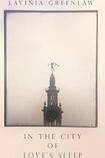
“If an 18th-century marquetry tea caddy was varnished 40 years ago, should that varnish be removed as inauthentic?” one of the fortysomething protagonists of poet Lavinia Greenlaw’s third novel asks themselves. “Or was it now part of the object’s story? And what did it mean to restore something when you could never make it new?”
This question of whether damaged or broken things can be restored is central to In the City of Love's Sleep: a fable, or a "slight history", of an autumnal love affair. Iris and Raif are "neither beautiful nor certain nor young" when they are drawn to each other upon first meeting. Both are ambivalent and, for one reason or another, prohibited access to easy joy. Iris, an anxious museum conservator seen by others as "this unsmiling woman", has trouble fully accepting or giving love due to the infidelity of her husband with whom she has two daughters, mistreatment by past lovers, and being raised by an uncaring mother.
Raif, an academic who has written a single book about “absence in the 17th-century curiosity cabinet”, is in the second year of grieving his wife Liis. (In life she was herself remote. He had originally been “drawn to . . . a withholding that balances something similar in himself”.) And yet Iris and Raif almost instantaneously feel something towards each other which they might never have felt before; to rush in, though, is impossible. Acting on their attraction, or love, will take much consideration and compromise.
Dreamlike atmosphere
The sense that the lovers are not only impenetrable to those around them, but to each other and themselves, creates a pleasing, almost dreamlike atmosphere. Raif, who has Arabic, East Asian and French heritage, often feels he doesn’t know how to answer the question of “who are you?”; this vagueness affects even people drawn to him: “And while [Iris] couldn’t describe his face, she would remember the pleasure of being unable to place him.” The pair swim in this vagueness, with the main solidity coming from Greenlaw’s narration, which tells us things directly without failing to dramatise the action, or let us see for ourselves. It moves in and out of one person’s struggle to reach out to and empathise with the other.
This story is complemented by page-long chapters about objects in Iris's museum antique yardsticks, contraptions used to measure the speed of clouds in the 1860s, or keep patients breathing in the 1930s – which function as little curiosity cabinets within the text. London, often referred to non-specifically as "the city" or "this city", also becomes the focal point for some of these slightly parabolic digressions. But we are only in London to the extent that the cities Marco Polo describes in Italo Calvino's Invisible Cities are Venice. Greenlaw's is an abstract city, an invisible city built out of impressions that become lessons.
Protagonists’ numbness
These are enriching if perhaps too neat. A good chapter called “The Towers” ends with this pronouncement: “Like the tallest towers in the city, from a certain distance our beginnings and endings are all that can be seen.” Towards the end of a page on “the heart”, we are told “the cartoon shape is the one we find easiest to grasp and remember. It is not, on the whole, a reflection of the way we feel.” This can all feel slightly sententious. The novel is at its best when not aspiring to this Julian Barnes-esque tone of urbane wisdom.
Much more satisfying are moments where the novel’s atmosphere – made detached and numb by its protagonists’ own numbness – thaws around peripheral characters who more outwardly require love and care, especially when Raif and Iris are braced to withhold from them. Where Iris can appear quite cavalier about her estranged husband David’s multiple sclerosis and subsequent stroke, as well as unsympathetic to their daughters’ need of him, Raif is largely oblivious to the feelings of Helen: a young woman who wants to make a life with him, and who has given him succour through his first year of grief. The raw needs of these secondary characters – along with Raif’s mother, who is in the early stages of dementia – become the basis for very powerful, acutely observed scenes. These function as oases of sentiment that chafe against the tightness of the novel’s design, and seem to enact the reawakening of feeling which our protagonists experience.
There are slight compromises throughout this very good novel. But that seems in fact to almost bolster In the City of Love's Sleep, which is a novel about compromise: intensely felt attraction and love that never gets to escape practicality and the baggage of a life. A love that can't ever be unjaded but is not lesser for that: even when those who feel it "will never be happy in a complete way again".










